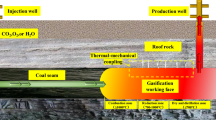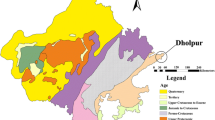Abstract
Increasing the deeper understanding of the thermal damages and failure mechanisms of sandstone undergoing thermal treatments at different temperatures is a key concern for deep-mining and underground coal gasification processes. In this research study, a scanning electron microscope (SEM) apparatus, JSM-5410LV, which was equipped with a built-in digital electro-hydraulic servo loading system, was applied to carry out a series of three-point bending tests on Pingdingshan sandstone following heat treatments at elevated and high temperatures ranging from 25 to 600 °C. The subcritical crack initiation load, peak load, and elastic modulus were found to increase with the increases in the thermal treatment temperatures until a maximum was achieved at 125 °C, after which decreases were observed. However, it should be noted that there were sudden drops observed for the specimens after the thermal treatment temperature reached 150 °C due to the thermal diffusivity of the cement. The subcritical crack growth length was theoretically calculated, and a digital speckle correlation method (DSCM) was applied to verify the initial load and subcritical crack growth length. It was found that the fracture toughness fluctuated significantly when the thermal treatment temperature ranged from 25 to 125 °C, and reached a peak of 47.45 MPa mm0.5. It was also observed that, as the temperature was raised from 175 to 600 °C, the fracture toughness gradually decreased. The subcritical crack growth mode was determined to be intra-granular cracking following the thermal treatments below 125 °C, while a mixture of intra-granular and trans-granular cracking occurred in the specimens which experienced thermal treatments of 175 °C. The relationship between heat treatment temperature and subcritical crack growth was derived, which could be used to develop geothermal energy extraction from the critical temperature resources.













Similar content being viewed by others
Abbreviations
- \(\delta\) :
-
Displacement of sandstone (L)
- \({\delta _{{\text{cr}}}}\) :
-
Displacement in the absence of notch (L)
- \({\delta _{{\text{nc}}}}\) :
-
Additional displacement due to presence of notch (L)
- \(a\) :
-
Crack length before the peak (L)
- \({a_0}\) :
-
Length of prefabricated notch (L)
- \({a_{\text{c}}}\) :
-
Subcritical crack growth length (L)
- \(b\) :
-
Width of the specimen (L)
- \({C_{\text{n}}}\) :
-
Correlative degree between two grey sets of the same pixel
- \(E\) :
-
Elastic modulus (M L−1 T−2)
- \(h\) :
-
Height of specimen (L)
- \(K\) :
-
Slope of the load–deflection curve from 30 to 70% of the peak load
- \({K_{{\text{IC}}}}\) :
-
Fracture toughness (M L−1.5 T−2)
- \(K_{{{\text{IC}}}}^{{{\text{ini}}}}\) :
-
Initial fracture toughness (M L−1.5 T−2)
- \(K_{{{\text{IC}}}}^{{{\text{um}}}}\) :
-
Unstable fracture toughness (M L−1.5 T−2)
- \(l\) :
-
Effective span (L)
- \(P\) :
-
Load (M L T−2)
- \({P_{{\text{ini}}}}\) :
-
Crack initiation load (M L T− 2)
- \({P_{\hbox{max} }}\) :
-
Peak load (M L T− 2)
- \({P_{{\text{um}}}}\) :
-
Subcritical crack initiation load (M L T− 2)
References
Atkinson BK (1984) Subcritical crack growth in geological materials. J Geophys Res Sol Earth 89:4077–4114. https://doi.org/10.1029/JB089iB06p04077
Brown W, Srawley J (1966) Plane strain crack toughness testing of high strength metallic materials. Plane strain crack toughness testing of high strength metallic materials. ASTM International, West Conshohocken
Chen S, Yang C, Wang G (2017) Evolution of thermal damage and permeability of Beishan granite. Appl Therm Eng 110:1533–1542. https://doi.org/10.1016/j.applthermaleng.2016.09.075d
Chong K, Kuruppu M (1984) New specimen for fracture toughness determination for rock and other materials. Int J Fract 26:R59–R62. https://doi.org/10.1007/BF01157555
Chopra PN (1997) High-temperature transient creep in olivine rocks. Tectonophysics 279:93–111. https://doi.org/10.1016/S0040-1951(97)00134-0
Erarslan N (2016) Microstructural investigation of subcritical crack propagation and fracture process zone (FPZ) by the reduction of rock fracture toughness under cyclic loading. Eng Geol 208:181–190. https://doi.org/10.1016/j.enggeo.2016.04.035
Fan X, Lin H, Cao R (2018) Bending properties of granite beams with various section-sizes in three-point bending tests. Geotech Geol Eng. https://doi.org/10.1007/s10706-018-0504-0. Accessed 19 Feb 2018
Glover P et al (1995) α/β phase transition in quartz monitored using acoustic emissions. Geophys J Int 120:775–782. https://doi.org/10.1111/j.1365-246X.1995.tb01852.x
Guo L-P, Sun W, He X-Y, Xu Z-B (2008) Application of DSCM in prediction of potential fatigue crack path on concrete surface. Eng Fract Mech 75:643–651. https://doi.org/10.1016/j.engfracmech.2007.01.023
Han J, Sun Q, Xing H, Zhang Y, Sun H (2017) Experimental study on thermophysical properties of clay after high temperature. Appl Therm Eng 111: 847–854 https://doi.org/10.1016/j.applthermaleng.2016.09.168
Heuze F (1983) High-temperature mechanical, physical and thermal properties of granitic rocks—a review. Int J Rock Mech Min Sci 1:3–10. https://doi.org/10.1016/0148-9062(83)91609-1 (Elsevier)
Ip KH, Stuart BH, Thomas PS, Ray AS (2008) Thermal characterization of the clay binder of heritage Sydney sandstones. J Therm Anal Calorim 92:97–100. https://doi.org/10.1007/s10973-007-8743-y
Jaeger JC, Cook NG, Zimmerman R (2009) Fundamentals of rock mechanics. Blackwell, London
Jiang G, Zuo J, Li L, Ma T, Wei X (2018) The evolution of cracks in Maluanshan granite subjected to different temperature processing. Rock Mech Rock Eng 51:1683–1695. https://doi.org/10.1007/s00603-018-1403-7
Ko TY, Kemeny J (2013) Determination of the subcritical crack growth parameters in rocks using the constant stress-rate test International. Int J Rock Mech Min Sci 59:166–178. https://doi.org/10.1016/j.ijrmms.2012.11.006
Kong B, Wang E, Li Z, Wang X, Liu J, Li N (2016) Fracture mechanical behavior of sandstone subjected to high-temperature treatment and its acoustic emission characteristics under uniaxial compression conditions. Rock Mech Rock Eng 49:4911–4918. https://doi.org/10.1007/s00603-016-1011-3
Li L, Tsui Y, Lee P, Tham L, Li T, Ge X (2002) Progressive cracking of granite plate under uniaxial compression. Chin J Rock Mechan Eng 21(7):940–947 (in Chinese)
Liu S, Xu J (2014) Mechanical properties of Qinling biotite granite after high temperature treatment. Int J Rock Mech Min Sci 71:188–193. https://doi.org/10.1016/j.ijrmms.2014.07.008
Meredith P, Atkinson B (1985) Fracture toughness and subcritical crack growth during high-temperature tensile deformation of Westerly granite and Black gabbro. Phys Earth Planet Inter 39:33–51. https://doi.org/10.1016/0031-9201(85)90113-X
Nara Y, Takada M, Igarashi T, Hiroyoshi N, Kaneko K (2009) Subcritical crack growth in rocks in an aqueous environment. Explor Geoghys 40:163–171. https://doi.org/10.1071/eg08102
Paterson MS, Wong T-f (2005) Experimental rock deformation—the brittle field. Springer, Berlin
Ranjith PG, Viete DR, Chen BJ, Perera MSA (2012) Transformation plasticity and the effect of temperature on the mechanical behaviour of Hawkesbury sandstone at atmospheric pressure. Eng Geol 151:120–127. https://doi.org/10.1016/j.enggeo.2012.09.007
Singh G, Zimmerman RW (2014) Modification of Griffith–McClintock–Walsh model for crack growth under compression to incorporate stick-slip along the crack faces. Int J Rock Mech Min Sci 72:311–318. https://doi.org/10.1016/j.ijrmms.2014.09.020
Sirdesai NN, Singh TN, Gamage RP (2017) Thermal alterations in the poro-mechanical characteristic of an Indian sandstone—a comparative study. Eng Geol 226:208–220. https://doi.org/10.1016/j.enggeo.2017.06.010
Su C, Wei S, Qin B, Yang Y (2017) Experimental study of influence mechanism of high temperature on mechanical properties of fine-grained sandstone. Rock Soil Mech 38:623–630 (in Chinese)
Tada H, Paris PC, Irwin GR (2000) The Stress Analysis of Cracks Handbook. Wiley, United Kingdom
Tian H, Kempka T, Yu S, Ziegler M (2016) Mechanical properties of sandstones exposed to high temperature. Rock Mech Rock Eng 49:321–327. https://doi.org/10.1007/s00603-015-0724-z
Tian H, Mei G, Jiang G-S, Qin Y (2017) High-temperature influence on mechanical properties of diorite. Rock Mech Rock Eng 50:1661–1666. https://doi.org/10.1007/s00603-017-1185-3
Yang S-Q, Ranjith PG, Jing H-W, Tian W-L, Ju Y (2017) An experimental investigation on thermal damage and failure mechanical behavior of granite after exposure to different high temperature treatments. Geothermics 65:180–197. https://doi.org/10.1016/j.geothermics.2016.09.008
Yin T-b, Shu R-h, Li X-b, Wang P, Liu X-l (2016) Comparison of mechanical properties in high temperature and thermal treatment granite. Trans Nonferr Metal Soc 26:1926–1937. https://doi.org/10.1016/s1003-6326(16)64311-x
Zhao Z (2016) Thermal influence on mechanical properties of granite: a microcracking perspective. Rock Mech Rock Eng 49(3):747–762. https://doi.org/10.1007/s00603-015-0767-1
Zimmerman RW (1985) The effect of microcracks on the elastic moduli of brittle materials. J Mater Sci Lett 4:1457–1460. https://doi.org/10.1007/BF00721363
Zuo J-P, Xie H-P, Zhou H-W, Peng S-P (2007a) Experimental research on thermal cracking of sandstone under different temperature. Chin J Geophys Chin Edn 50:1150–1155 (in Chinese)
Zuo J, Xie H, Zhou H, Peng S (2007b) Thermal-mechanical coupled effect on fracture mechanism and plastic characteristics of sandstone. Sci China Ser E 50:833–843. https://doi.org/10.1007/s11431-007-0081-6
Zuo J-p, Li H-t, Xie H-p, Ju Y, Peng S-p (2008) A nonlinear strength criterion for rock-like materials based on fracture mechanics. Int J Rock Mech Min Sci 45:594–599. https://doi.org/10.1016/j.ijrmms.2007.05.010
Zuo J-p, Xie H-p, Dai F, Ju Y (2014) Three-point bending test investigation of the fracture behavior of siltstone after thermal treatment. Int J Rock Mech Min Sci 70:133–143. https://doi.org/10.1016/j.ijrmms.2014.04.005
Acknowledgements
The authors gratefully acknowledge the support from the National Natural Science Foundation of China (11572343, 51622404), Yueqi outstanding scholar Award Program by CUMTB, the State Key Research Development Program of China (2016YFC0801404) and Outstanding Young Talents of “Ten Thousand People Plan”.
Author information
Authors and Affiliations
Corresponding authors
Additional information
Publisher’s Note
Springer Nature remains neutral with regard to jurisdictional claims in published maps and institutional affiliations.
Rights and permissions
About this article
Cite this article
Zuo, J., Li, Y., Zhang, X. et al. The effects of thermal treatments on the subcritical crack growth of Pingdingshan sandstone at elevated high temperatures. Rock Mech Rock Eng 51, 3439–3454 (2018). https://doi.org/10.1007/s00603-018-1527-9
Received:
Accepted:
Published:
Issue Date:
DOI: https://doi.org/10.1007/s00603-018-1527-9




